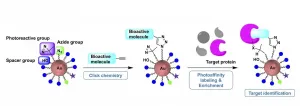(Press-News.org) Current advice from the America Dental Association tells you that if your gums bleed, make sure you are brushing and flossing twice a day because it could be a sign of gingivitis, an early stage of periodontal disease. And that might be true. So if you are concerned, see your dentist. However, a new University of Washington study suggests you should also check your intake of vitamin C.
"When you see your gums bleed, the first thing you should think about is not, I should brush more. You should try to figure out why your gums are bleeding. And vitamin C deficiency is one possible reason," said the study's lead author Philippe Hujoel, a practicing dentist and professor of oral health sciences in the UW School of Dentistry.
Hujoel's study, published Feb. 1 in Nutrition Reviews, analyzed published studies of 15 clinical trials in six countries, involving 1,140 predominantly healthy participants, and data from 8,210 U.S. residents surveyed in the Centers for Disease Control and Prevention's Health and Nutrition Examination Survey. The results showed that bleeding of the gums on gentle probing, or gingival bleeding tendency, and also bleeding in the eye, or retinal hemorrhaging, were associated with low vitamin C levels in the bloodstream. And, the researchers found that increasing daily intake of vitamin C in those people with low vitamin C plasma levels helped to reverse these bleeding issues.
Of potential relevance, says Hujoel, who is also an adjunct professor of epidemiology in the UW School of Public Health, both a gum bleeding tendency and retinal bleeding could be a sign of general trouble in one's microvascular system, of a microvascular bleeding tendency in the brain, heart and kidneys.
The study does not imply that successful reversing of an increased gingival bleeding tendency with vitamin C will prevent strokes or other serious health outcomes, Hujoel stresses. However, the results do suggest that vitamin C recommendations designed primarily to protect against scurvy -- a deadly disease caused by extremely low vitamin C levels -- are too low, and that such a low vitamin C intake can lead to a bleeding tendency, which should not be treated with dental floss.
Consequently, Hujoel does recommend people attempt to keep an eye on their vitamin C intake through incorporation of non-processed foods such as kale, peppers or kiwis into your diet, and if you can't find palatable foods rich in vitamin C to consider a supplement of about 100 to 200 milligrams a day.
If someone is on a specialized diet, such as a paleo diet, it's important that they take a look at their vitamin C intake, Hujoel said. "Vitamin C-rich fruits such as kiwis or oranges are rich in sugar and thus typically eliminated from a low-carb diet."
This avoidance may lead to a vitamin C intake that is too low and is associated with an increased bleeding tendency. People who exclusively eat lean meats and avoid offal, the vitamin-rich organ meats, may be at a particularly high risk for a low vitamin C intake.
The association between gum bleeding and vitamin C levels was recognized more than 30 years ago. In fact, two studies co-authored by former dean of the UW School of Dentistry Paul Robertson (published in 1986 and 1991) identified gum bleeding as a biological marker for vitamin C levels.
However, this connection somehow got lost in dental conversations around bleeding gums.
"There was a time in the past when gingival bleeding was more generally considered to be a potential marker for a lack of vitamin C. But over time, that's been drowned out or marginalized by this overattention to treating the symptom of bleeding with brushing or flossing, rather than treating the cause," Hujoel said.
Hujoel's literature review also determined that "retinal hemorrhaging and cerebral strokes are associated with increased gingival bleeding tendency, and that (vitamin C) supplementation reverses the retinal bleeding associated with low (vitamin C) plasma levels."
So, missing the possible connection between gum bleeding and low levels of vitamin C has the potential to have serious health consequences.
The study authors write: "A default prescription of oral hygiene and other periodontal interventions to 'treat' microvascular pathologies, even if partially effective in reversing gingival bleeding as suggested in this meta-analysis, is risky because it does not address any potential morbidity and mortality associated with the systemic microvascular-related pathologies."
INFORMATION:
Co-authors include Tomotaka Kato, Department of Oral Health Sciences, UW School of Dentistry; Isabel Hujoel, Division of Gastroenterology and Hepatology, Mayo Clinic; and Margaux L.A. Hujoel, Department of Biostatistics, Harvard T.H. Chan School of Public Health.
For more information, contact Hujoel at hujoel@uw.edu.
The development of pharmaceutical treatments is difficult -- clinicians and researchers know a certain drug can regulate particular functions, but they might not know how it actually works. Researchers at Tokyo University of Agriculture and Technology (TUAT) have developed a new, streamlined method to better understand the molecular mechanisms underpinning these interactions.
They published their approach on Dec. 17, 2020 in Organic & Biomolecular Chemistry, a journal of the U.K. Royal Society of Chemistry.
"We set out to develop a new gold nanoparticle-based method for target identification of bioactive small molecules that streamlines the current laborious steps so that we can rapidly find out how these molecules ...
In a review of national firearm data spanning more than 20 years, researchers at Oregon Health & Science University have identified alarming trends regarding increasing rates of firearm-related deaths among some of America's youngest residents.
According to lead researcher Archie Bleyer, M.D., the rate of unintentional firearm deaths in children ages 1 - 4 increased exponentially at an average annual percent of 4.9 between 1999 and 2018, with the greatest impact among non-Hispanic Black and White children. This rate is more than eight times higher than any other highly developed country ...
You can't have your cake and eat it too, as the saying goes. But what if you could save your slice while enjoying the benefits at the same time? New research suggests this is possible when it comes to marine reserves.
Marine protected areas (MPAs) are among the best conservation tools at our disposal today. However, by their very nature, these reserves take away fishing grounds, which can make them unattractive to commercial fishermen. Scientists and resource managers often promote MPAs as beneficial for the fishery. In theory, they provide a refuge for stocks to rebuild and spill over into nearby waters, leading ...
More fully appreciating family and engaging in more conflict are among the heightened experiences during the coronavirus pandemic, according to a new UC Riverside study.
The study from David Funder's psychology lab looked at how people experience everyday life and its situations and how those experiences change because of an extraordinary event - the global pandemic.
Undergraduate students took part in the study, which first collected responses from 544 of them in 2017, and then from 123 students during the pandemic in spring 2020, when most of the participants were sheltering at home.
The before-and-during comparison isn't all roses for pandemic living. Some everyday experiences suffer, such as conversation, finding ...
The American College of Cardiology's Cardiovascular Summit will feature several poster presentations on care delivery, cost reduction and quality improvement that offer innovative concepts to combat access to care, especially during the ongoing COVID-19 pandemic and as the broader health care system works to improve health equity. Research examines the rapid adoption of virtual outpatient care, enabling rural primary care teams to improve cardiovascular health and optimizing emergency room use after clinic hours.
Summaries of embargoed abstracts are below. For access to the full abstracts ...
When it comes to developing drugs for mental illnesses, three confounding challenges exist:
Men and women experience them differently, with things like depression and anxiety far more common in females.
A drug that works for one person may not work for another, and side effects abound.
New CU Boulder research, published in the journal eLIfe, sheds light on one reason those individual differences may exist. Turns out a key protein in the brain called AKT may function differently in males than females.
The study also offers a closer look at where, precisely, in the brain things may go ...
Every late winter and early spring, huge dust storms swirled across the bare and frozen landscapes of Europe during the coldest periods of the latest ice age. These paleo-tempests, which are seldom matched in our modern climate frequently covered Western Europe in some of the thickest layers of ice-age dust found anywhere previously on Earth. This is demonstrated by a series of new estimates of the sedimentation and accumulation rates of European loess layers obtained by Senior Research Scientist Denis-Didier Rousseau from Ecole Normale Supérieure in Paris, France, and colleagues. The work, which is published in Quaternary Science Reviews is part of the TiPES project on tipping points in the Earth system, coordinated by The University ...
LA JOLLA--(February 1, 2021) Wolffia, also known as duckweed, is the fastest-growing plant known, but the genetics underlying this strange little plant's success have long been a mystery to scientists. Now, thanks to advances in genome sequencing, researchers are learning what makes this plant unique--and, in the process, discovering some fundamental principles of plant biology and growth.
A multi-investigator effort led by scientists from the Salk Institute is reporting new findings about the plant's genome that explain how it's able to grow so fast. The research, published in the February 2021 issue of Genome Research, will help scientists to understand how plants make trade-offs between ...
DALLAS, Feb. 1, 2021 -- Women with a history of diabetes during pregnancy (gestational diabetes) are twice as likely by mid-life to develop calcium in heart arteries - a strong predictor of heart disease - even if healthy blood sugar levels were attained many years after pregnancy, according to new research published today in the American Heart Association's flagship journal Circulation.
Gestational diabetes, which is high blood sugar levels (glucose intolerance) first recognized during pregnancy, affects approximately 9% of U.S. pregnancies and up to 20% worldwide. After pregnancy, women who had gestational diabetes are at higher risk of developing prediabetes or Type 2 diabetes, conditions that are risk factors ...
Irvine, Calif. -- Researchers from the University of California, Irvine and the University of Minnesota have found that an enriched diet and companionship can reduce pain in mice with sickle cell disease by increasing serotonin. They also discovered that duloxetine, an antidepressant that boosts serotonin levels, could be an alternative to opioids in treating chronic pain.
"Finding safe and effective alternatives to opioids is a research priority, especially for patients with sickle cell disease," said Dr. Keith Hoots, director of the Division of Blood Diseases and Resources at the National Heart, Lung, and Blood Institute. "It's encouraging to see a dose-response relationship to nutrients and companions in mice, ...



